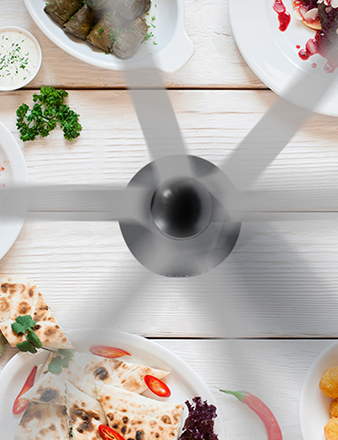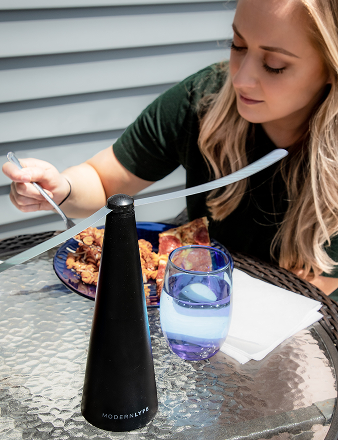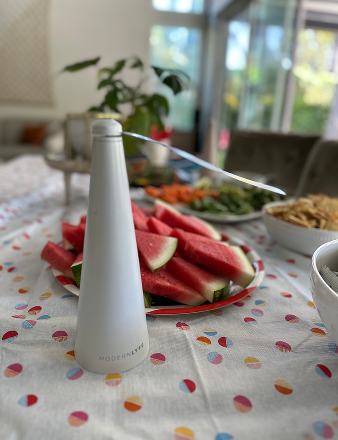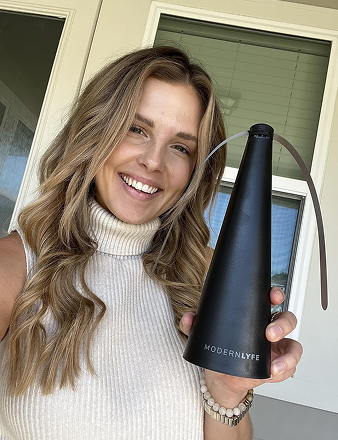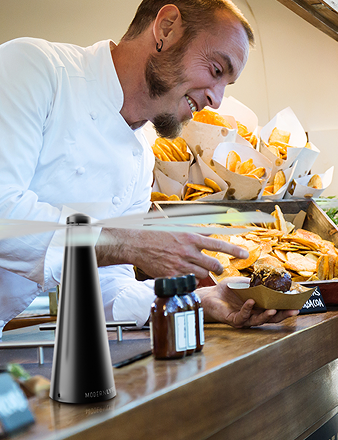Keeping flies away from your food outdoors requires a layered defense. Think of it as a three-part strategy: block them with physical barriers like food covers, disrupt their flight with air from fans, and eliminate what attracts them by keeping your space clean. Winning this battle is about being proactive, not just swatting them away at the last second.
Your Fly-Free Outdoor Meal Starts Here
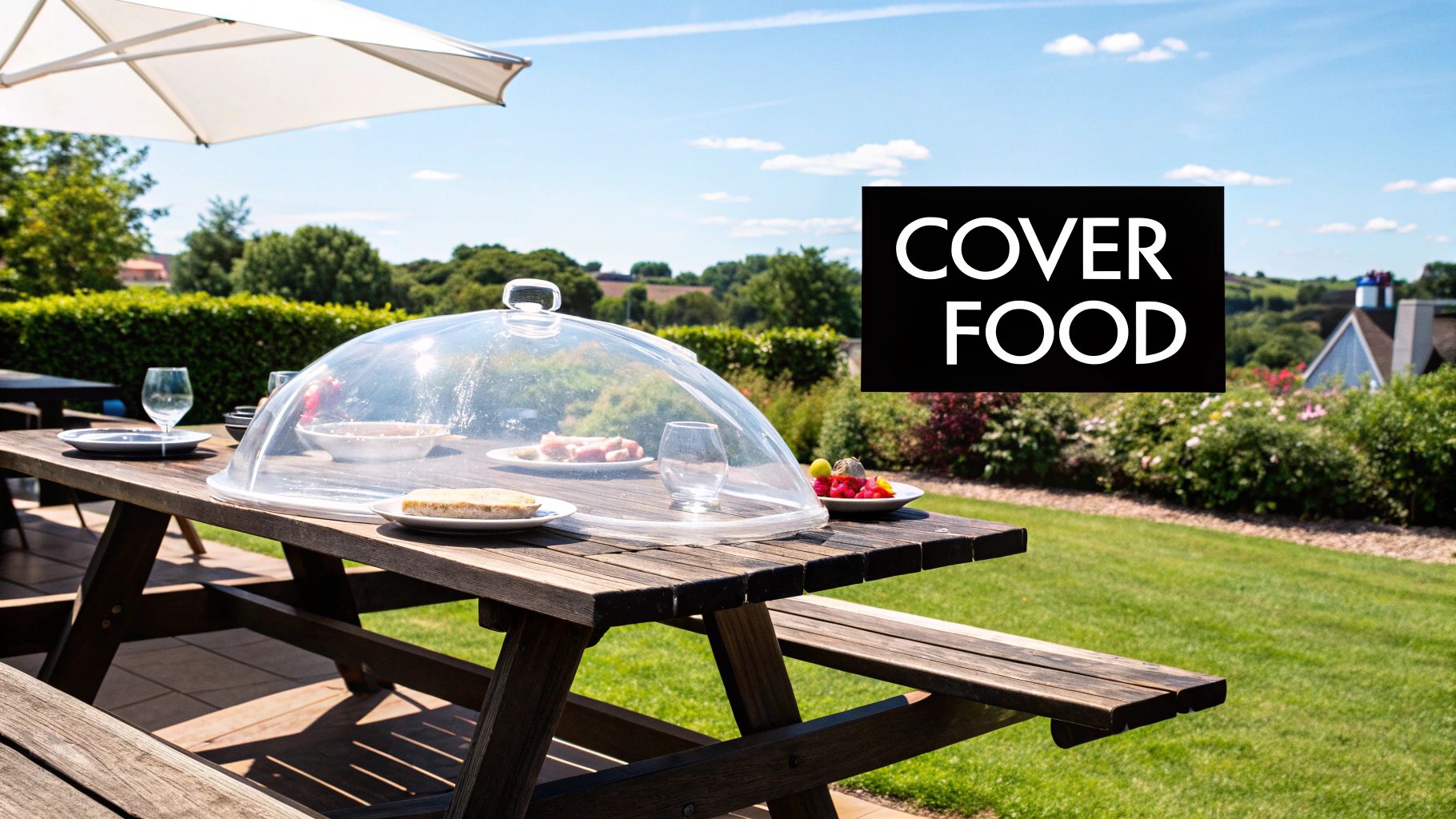
Nothing ruins a perfect outdoor meal faster than a swarm of flies. Before you give up and start swatting, know that beating these pests is about smart strategy, not luck. This guide delivers actionable, modern solutions that work—and we’re going way beyond just lighting a few citronella candles.
We'll break down how to build a defense system for your patio or picnic using simple tools and a bit of environmental savvy. The goal is to make your space completely unappealing to flies while putting up barriers they can't get past. Let’s start with immediate actions you can take to protect your food the second it’s served.
The Foundation of Fly Control
The best approach is a combination of tactics. Flies are drawn to two things: strong smells and still air. If you can disrupt those two factors, you’re already halfway to a peaceful meal. A single trick might give you temporary peace, but using several methods together creates a no-fly zone that lasts.
Your game plan should include:
- Active Deterrents: These are tools that work for you, like fans. The breeze they create is too much for a fly's delicate wings to handle.
- Physical Barriers: Simple but incredibly effective. This is anything that physically blocks flies from landing on your food.
- Environmental Cleanup: This is the prep work. It means removing what brought flies to your yard in the first place, like open trash cans, pet waste, or spilled drinks.
The goal isn't just to shoo away the flies you see. It's to make your dining area an unappealing destination for any new ones. Shifting your mindset from reactive swatting to proactive prevention is what makes all the difference.
Layering these techniques makes everything more effective. For instance, a simple fly cover for food is great, but it’s even better when you’ve already reduced the local fly population with a quick cleanup. We'll cover all these steps to help you reclaim your outdoor dining.
For a quick reference, here are the immediate actions you can take to create a no-fly zone right now.
Quick Fly Defense Checklist
| Action Item | Why It Works | Best For |
|---|---|---|
| Cover Food Immediately | The simplest barrier. If they can't smell or touch it, they can't contaminate it. | Buffets, potlucks, and any dish not being actively served. |
| Set Up a Fan | Flies are weak fliers and avoid strong air currents. A gentle breeze is like a hurricane to them. | Patios, decks, and picnic tables where you have access to power or a battery source. |
| Clean Up Spills & Crumbs | Removes the scent trails that attract flies to your table in the first place. | High-traffic areas, especially around kids' seating and drink stations. |
This checklist is your starting point. By tackling these basics, you immediately make your dining area a much less friendly place for flies.
Prepare Your Yard to Repel Flies Naturally
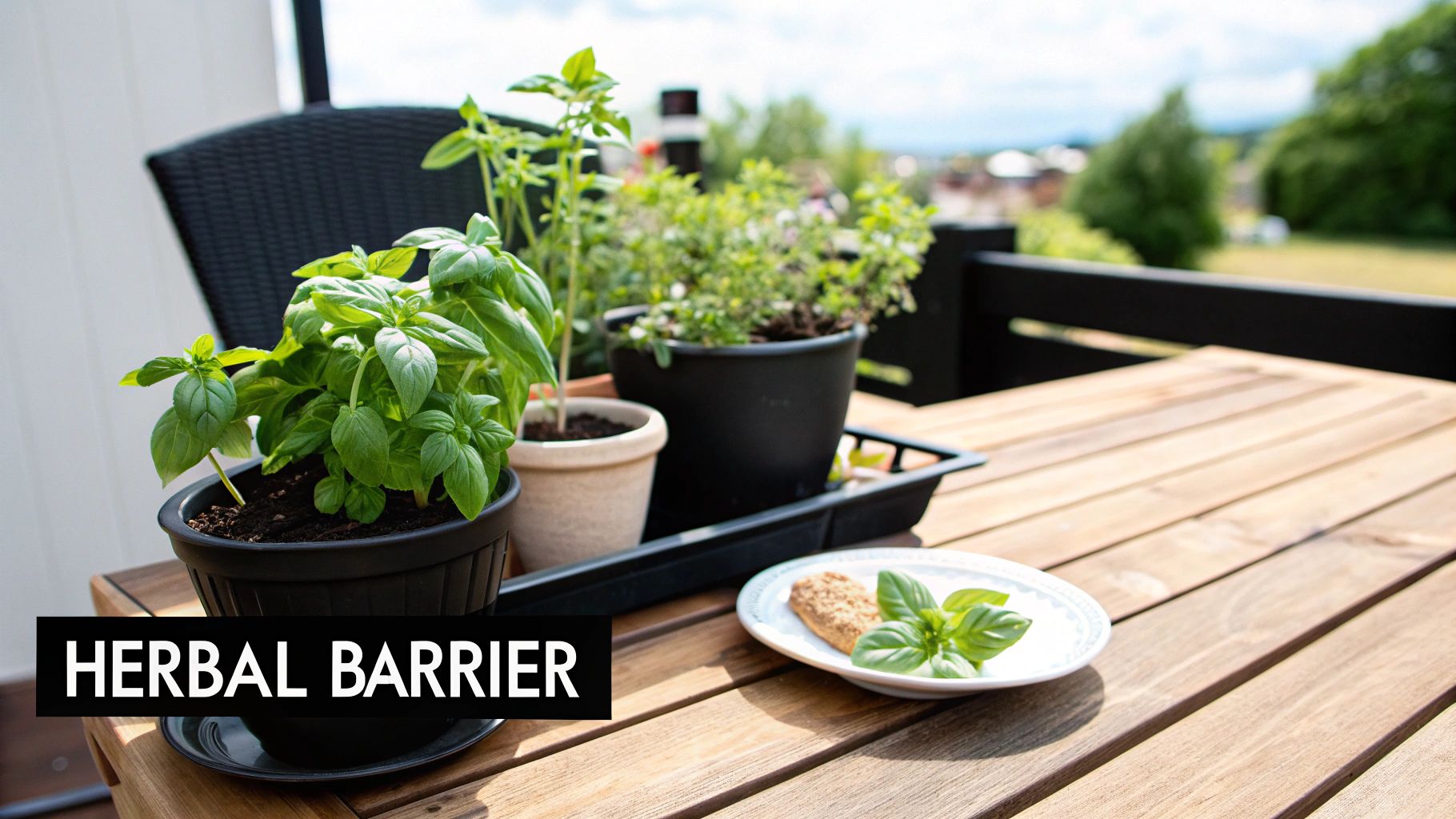
Long before you bring food outside, you can set the stage for a fly-free gathering. The trick is to make your yard as uninviting as possible for these pests. It’s all about preventative maintenance—thinking like a fly to figure out what draws them in, then taking it away.
Flies are simple. They’re always looking for a meal and a place to lay eggs. Things like damp compost piles, standing water, and old garbage are a five-star resort for them. If you manage these attractants, you’ll dramatically cut down on the number of unwanted guests buzzing around your party.
Eliminate Fly Breeding Grounds
Start by walking around your yard and looking at it from a fly's perspective. You're searching for potential fly nurseries, and they're often in places you might overlook.
Here are a few things to do before having people over:
- Mow a Day or Two Early: Freshly cut grass clippings can be a huge draw for insects. Mowing a couple of days ahead gives them time to dry out and become less appealing.
- Be Diligent About Pet Waste: This is a big one. Pet waste is a major food source and breeding ground for flies. Make sure it's cleaned up completely.
- Dump Out Standing Water: Check flowerpot saucers, birdbaths, old tires, and clogged gutters. It doesn’t take much stagnant water to create a hotspot for both flies and mosquitoes.
This cleanup is the foundation of any good pest control strategy. Flies need moisture and organic material to reproduce. For example, fresh manure can have 60-80% moisture, perfect for larvae. While you probably don't have manure in your yard, the same principle applies to wet leaves, compost bins, and pet waste. The Ohio State University Extension has great insights into how sanitation directly impacts fly populations.
Remember, a clean environment is your first line of defense. The fewer attractants available, the fewer flies you'll have to deal with at mealtime.
Finally, check your trash situation. Make sure your bins have lids that seal tightly. If you can, move them far away from your dining area—bonus points if you can place them downwind. Getting these basics right makes every other fly-repelling effort, from fans to traps, much more effective.
Protecting Food Directly on Your Table
The moment the food comes out, the real battle begins. Your focus needs to shift to the tabletop itself to create an immediate and effective defense right where flies want to land. A multi-layered strategy is what really works, building a powerful no-fly zone around your dishes.
The star player here is a modern fly fan. These aren't just gadgets; they're an incredibly effective tool for keeping your food safe outdoors. Their success boils down to two simple principles that flies can't handle.
First, they generate a constant, gentle breeze. Flies are clumsy fliers, and even a light air current makes it a challenge for them to navigate and land. It’s like trying to dock a tiny boat in choppy water—it’s just not going to happen.
Second, the soft, reflective blades disrupt their vision. A fly’s compound eyes are extremely sensitive to light and motion. The spinning, holographic patterns on the blades create visual chaos that they interpret as danger, so they instinctively stay away. You can dig into the science behind fly fans for food to see exactly why they're my top recommendation.
Getting Your Fan Placement Just Right
Where you put your fans makes all the difference. Don't just place one in the middle and call it a day—think strategically about your table's size and layout.
- Small, round table (seats up to 4): One fan placed in the center is usually plenty. It'll create enough overlapping airflow to cover the whole surface.
- Standard rectangular table (6-8 feet): This is a two-fan job. Position one fan toward each end of the table to ensure the protective breeze covers everything, leaving no gaps.
- Large buffet or serving line: For a long spread, place a fan every 3-4 feet. This creates a continuous curtain of moving air, shielding every dish.
The secret is creating overlapping zones of air movement. When the breeze from one fan's radius meets the next, you've built a barrier that flies find almost impossible to cross.
Other Smart Tabletop Tactics
While the fans do most of the work, a few extra tricks can bolster your defenses. Consider toning down the scent of your food. Serving things like potato salad, fruit, or coleslaw in chilled dishes not only keeps them fresher but also reduces the aromas that draw flies in from across the yard.
You can also use natural scents that flies hate. A few small pots of mint, basil, or rosemary on the table look great and act as a subtle, natural deterrent. They won't solve the problem on their own, but they add another layer to your defense.
The simple hygiene steps illustrated below are the foundation for everything else you do to prevent flies.
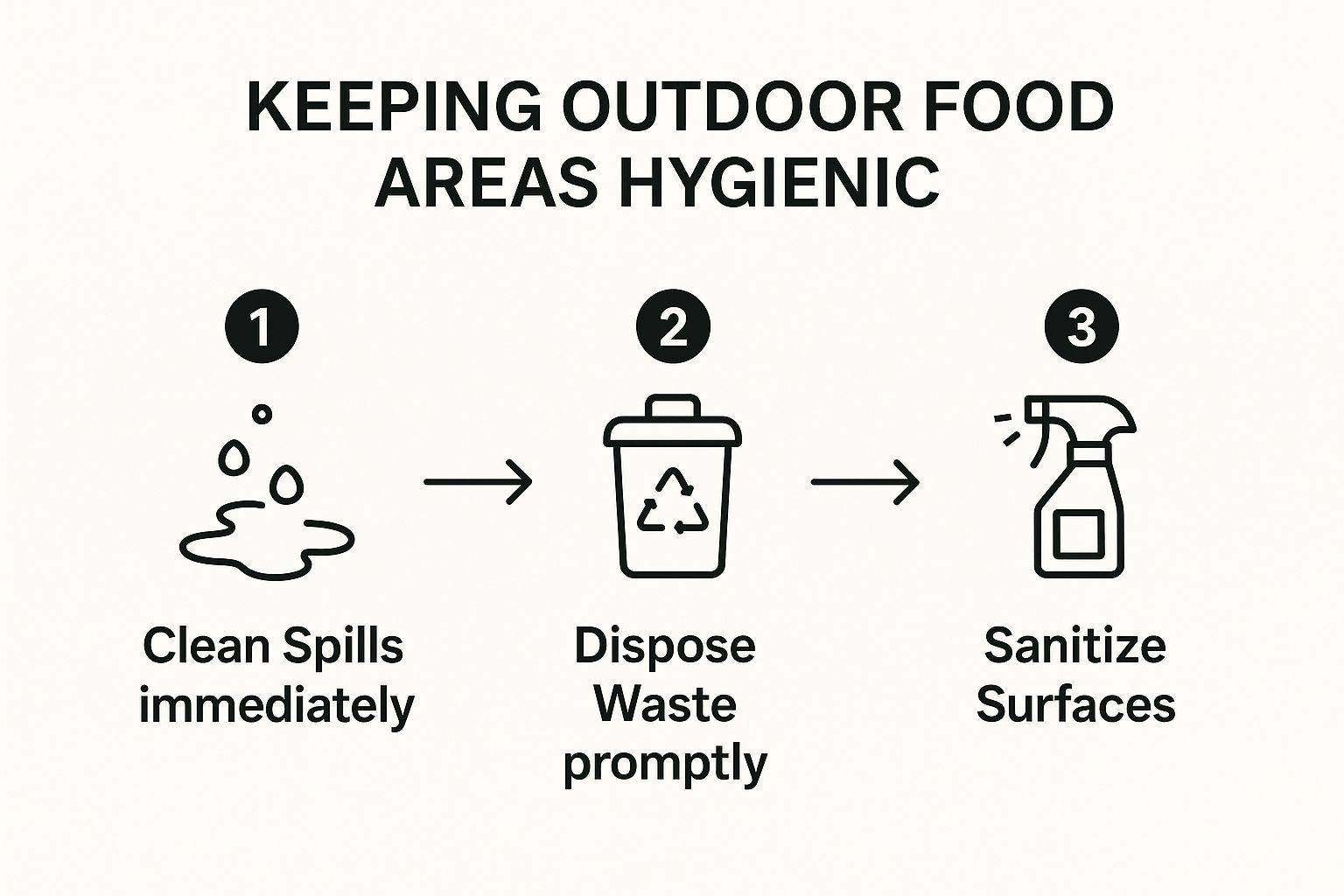
As you can see, immediate cleaning, smart waste disposal, and sanitizing surfaces are key. When you make the area less attractive to flies in the first place, all your other efforts become far more effective.
Create a Perimeter Defense
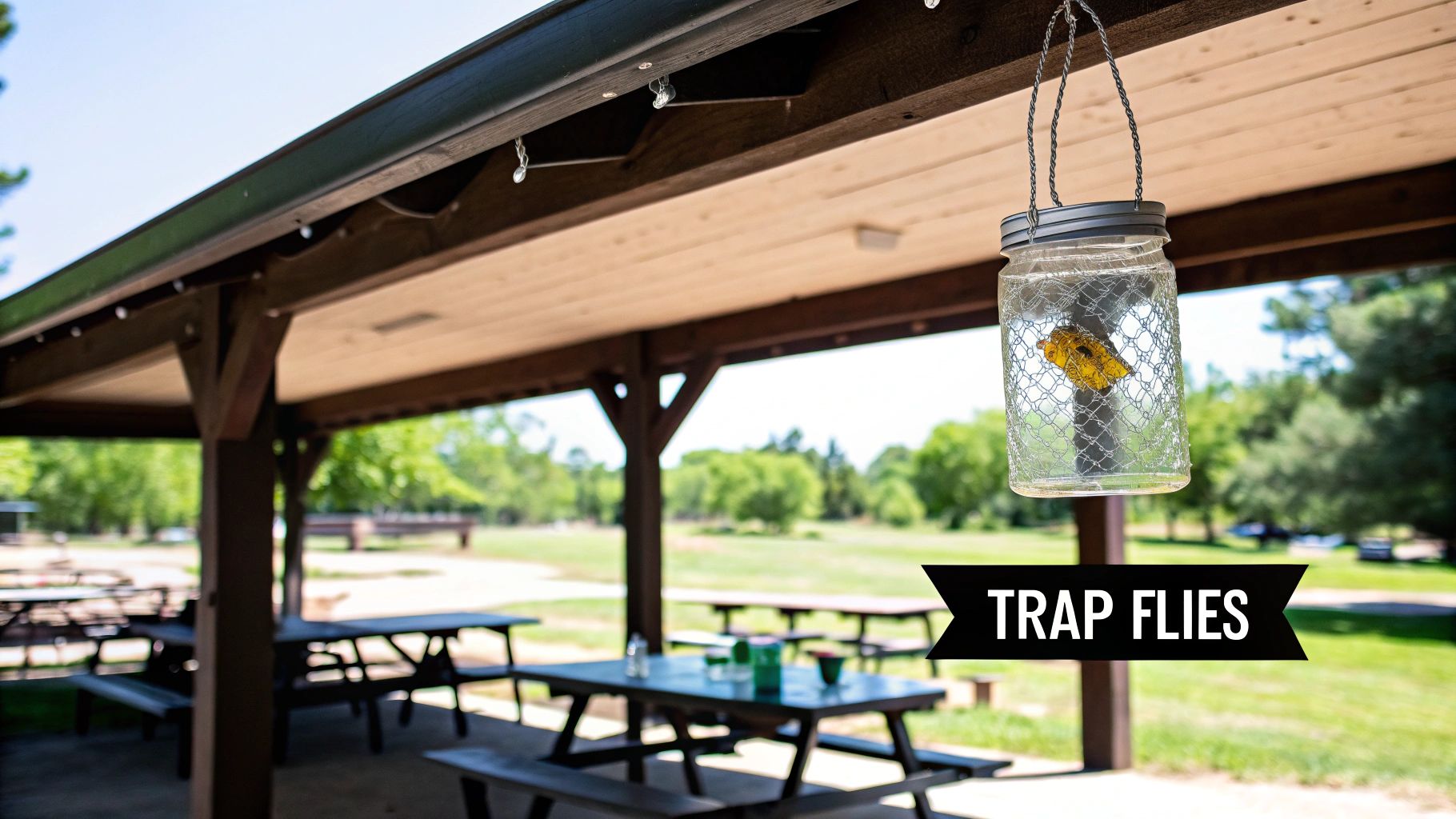
The best way to keep flies off your food is to stop them from ever getting near the table. You need to think like a general and establish a defensive line around your gathering. By creating a perimeter, you redirect flies away from your space, which means fewer buzzing pests to deal with.
The idea is to give flies a more tempting offer somewhere else. Baited traps are the workhorse of this strategy, but their success hinges on placement. Get it wrong, and you can actually make the problem worse by luring flies right into your party.
Get Strategic With Your Traps
The golden rule for placing baited fly traps: put them far enough away to lure flies, but not so close that they become part of the event. You're setting up a decoy, and decoys work best from a distance.
Here’s how to nail the placement:
- Distance Is Your Friend: Set traps at least 20-30 feet away from where people are eating or cooking. This creates a clear, alternative target well away from your food.
- Think About the Wind: Always place traps downwind of your gathering. Flies are masters at following scents on the breeze, so this ensures the trap’s attractant flows away from you, not toward you.
This isn’t just a backyard trick; it’s a tactic used by professional pest control. Studies show how potent baited traps can be. In some agricultural settings, a system of just six well-placed traps caught as many as 2,760 flies per trap per week. That’s a serious dent in the local fly population.
Bottom line: by making the edge of your yard a more appealing place for flies, you dramatically reduce the pest pressure on your actual dining area. This makes your tabletop defenses, like fly fans, even more effective.
You can buy commercial baited traps or make a DIY version with things like sugar water and vinegar. Either way, they are a critical part of a complete outdoor fly repeller plan. The goal is always the same—intercept the enemy before it reaches your plate.
Busting Fly Myths & Leveling Up Your Strategy
When you're fighting off flies, it's tempting to try old-school solutions. But let's be honest, how well do they really work?
Take sticky flypaper. It's a classic, but it's far from perfect for an outdoor gathering. Sure, it might snag a few unlucky flies, but it quickly becomes a gross, pollen-covered eyesore that loses its stickiness in the open air.
And what about those other home remedies you see online? A single citronella candle or a small bowl of vinegar isn't going to cut it against a determined swarm of flies. The real secret isn't finding one magic bullet; it's about creating a layered, intelligent defense.
The most effective approach is always an integrated one. Think of it like a security system for your picnic. You combine proactive sanitation (the foundation), physical barriers like fly fans (your active guards), and a strategic perimeter defense with traps. This system is far more reliable than any single gimmick.
Beyond the Backyard Basics
If you're dealing with a truly relentless fly problem, you might wonder what the pros do. Scientists have explored fascinating biological methods, like the Sterile Insect Technique (SIT). This method was famously successful in wiping out the screwworm fly. The process is clever: release sterilized male flies into the wild, they mate with females, and the population crashes because no offspring are produced.
But the common house fly is a different beast. Their populations are massive and dense, making SIT almost impossible on a local, backyard scale. You'd need a staggering number of sterile flies to make a small dent. If you're curious, you can dive deeper into these advanced fly control findings to see why it's not a simple DIY fix.
This is exactly why focusing on a system you can control is your best bet. A smart combination of sanitation, strategically placed fans, and a few good traps will give you the most immediate and satisfying results for your outdoor meals.
Your Outdoor Fly Prevention Questions Answered
Even with the best plan, questions pop up right when you're setting up for a barbecue. Here are quick answers to common curveballs that can throw off your fly-free gathering.
Think of this as your go-to troubleshooting guide for those "what if" scenarios every host runs into.
Do Certain Foods Attract More Flies?
Absolutely. Flies have an amazing sense of smell, and they aren't picky. Knowing what they love most helps you identify which dishes need extra protection.
The biggest fly magnets on your table are:
- Anything Sugary: Ripe fruit, cakes, sodas, and juices. That sweet scent is like a dinner bell for flies, and they can smell it from surprisingly far away.
- Meats and Proteins: Raw burgers waiting for the grill or a platter of cooked cold cuts are prime targets. The smell of protein is irresistible to them.
- Fermented Stuff: This might surprise you, but things like beer, wine, and even vinegar-heavy salad dressings can draw in certain types of flies.
A good rule of thumb? If it has a strong, sweet, or pungent smell, it’s a high-priority dish. This is exactly where you want to place your Modern Lyfe fly fans or use mesh food covers.
What If It's a Really Windy Day?
A windy day can be a mixed bag. On one hand, a good breeze is like a giant, natural fly fan. It makes it incredibly hard for flies to fly straight and land on your food, so you'll probably see fewer of them.
The catch is that wind can disrupt some of your other defenses. A lightweight food cover might go flying, and the scent from your perimeter traps could get scattered instead of luring flies away. You just have to adjust. Use heavier food tents or make sure your fly fans have a solid base so they don't topple over. Wind is a great assistant, but it's not a complete solution.
Your main strategy is still solid: keep things clean, protect the food directly, and control the perimeter. On a windy day, rely more on the tactics wind can't disrupt, like wiping up spills immediately and using your fly fans for targeted, close-range protection.
How Many Fly Fans Do I Actually Need?
This comes down to the size and shape of your food spread. The goal is to create overlapping zones of air movement, leaving no "calm air" gaps for a fly to slip through.
Based on what works best, here’s a good guide:
- Small Round Table (4-6 people): One fan placed in the middle usually does the trick.
- Standard Rectangular Table (6-8 feet long): You'll want two fans. Place one at each end of the main food area to create a protective breeze that covers the entire length.
- Large Buffet or Multiple Tables: For a long buffet line, a good formula is one fan for every 3-4 feet of food. This ensures everything from the first salad to the last dessert stays completely covered.
When in doubt, it’s always better to have a little too much coverage than not enough.
Ready to enjoy an outdoor meal without swatting at flies every five seconds? The right tools make all the difference. MODERN LYFE has fly fans that are not only super effective but also look great on your table.
Explore our collection of fly fans and take back your patio at Modern Lyfe.

